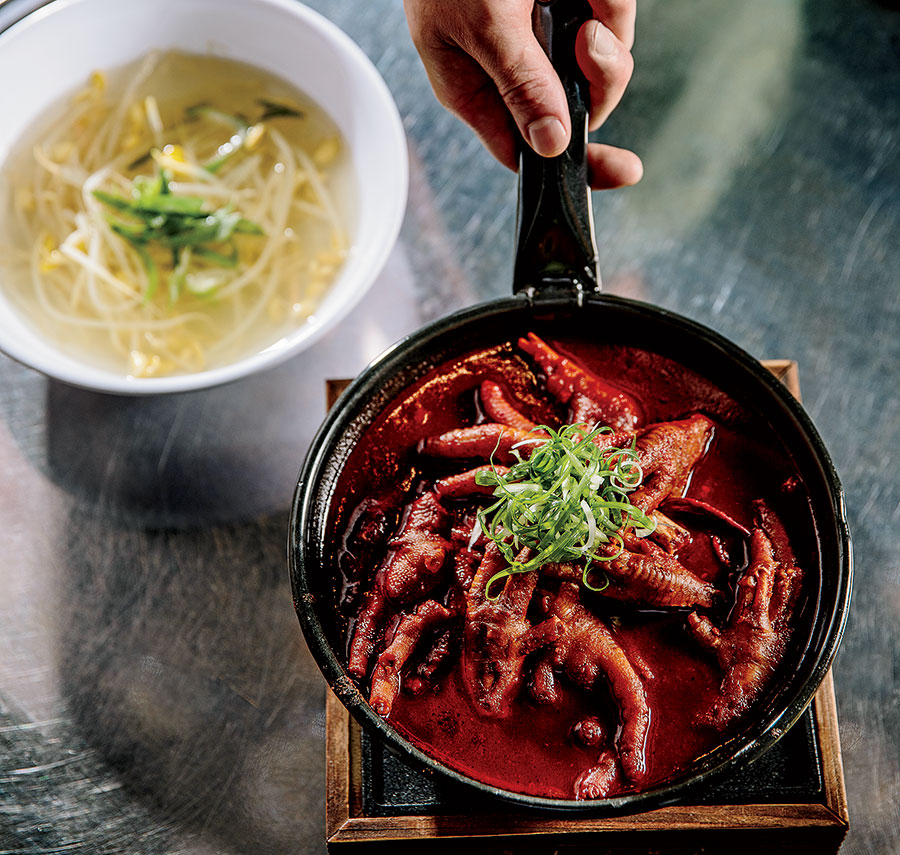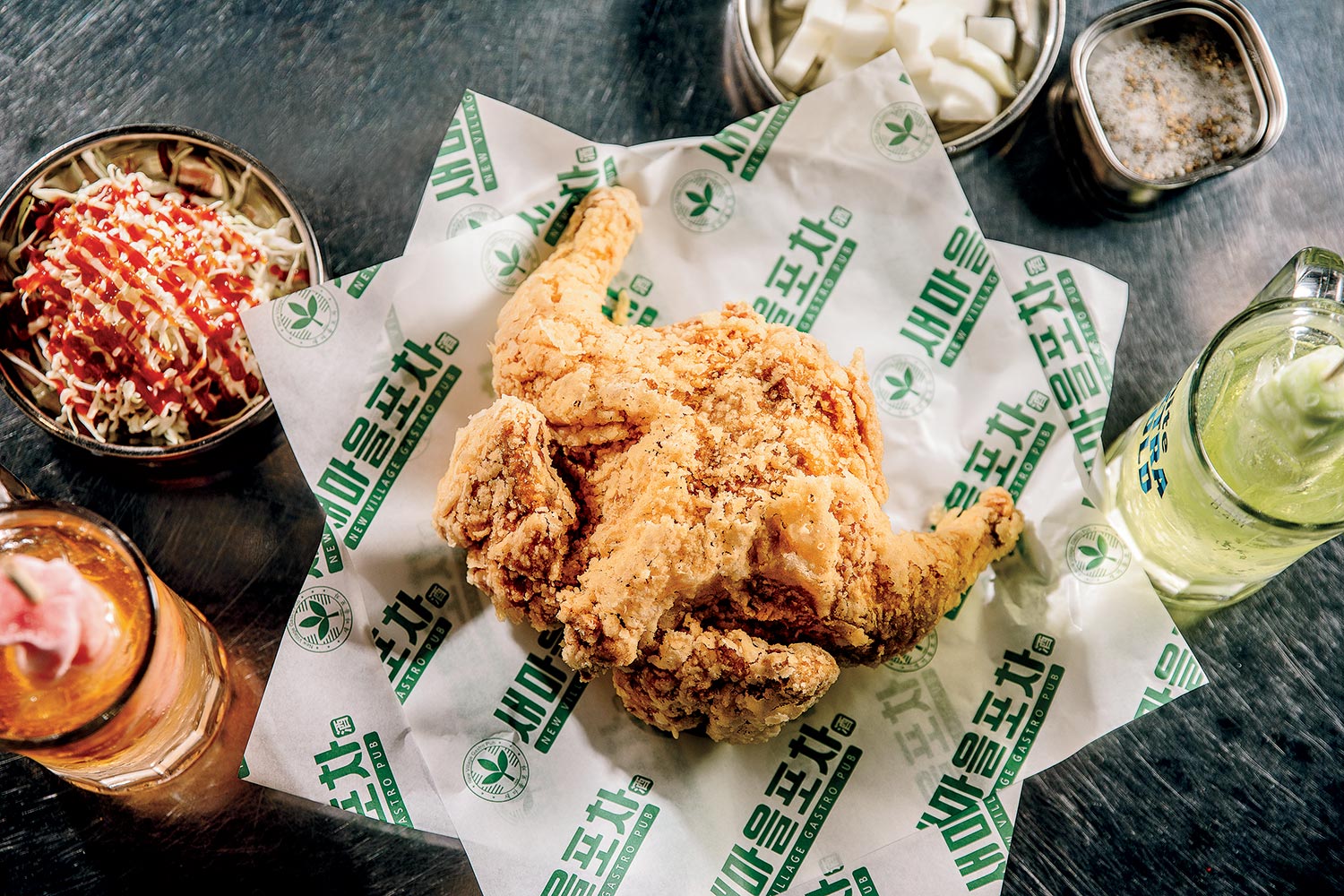James Shin chose to call his first restaurant Saemaul Pocha. He knew the name would be loaded with retro-cool connotations for Koreans and offer clues as to the menu and vibe. But how to translate it into English? Saemaul was easy enough: “new village.” It was also quite apt. If you haven’t recently followed this stretch of Milwaukee Avenue north through Glenview into Northbrook, where Shin set up shop, then you won’t believe its transformation. It is indeed a new village, where old strip malls (like the one housing this restaurant) are filled with new businesses and where shiny shopping centers crammed with Korean dining destinations have filled in the gaps. But pocha? How do you tell non-Koreans what a pocha is?
Well, for starters, it’s a contraction of pojangmacha, which means “covered wagon.” Yes, like in Little House on the Prairie. But really, a pocha is a tented street bar that looks like a covered wagon. These watering holes began staking claims on urban sidewalks after the Korean War for day laborers to enjoy inexpensive food and drink after their shifts.
Over time they became popular as a place to indulge in anju — Korea’s grand and glorious spectrum of spicy, fatty, face-stuffable bar foods — and also as a stop on a bar crawl. Few world citizens love their bar crawls as much as Koreans. (See “Carousing 1-2-3.”) But a pocha also had house specialties, which lured guests interested in dinner as well as carousing.
Shin cleverly came up with “gastropub” as a translation. New Village Gastro Pub. “We aren’t sit-down dining but not a pub per se,” Shin said. “My idea was to serve anju that could also be a meal. I wanted people to know they could come in and eat without drinking.” Any number of Chicagoans who grew up going with their parents to Twin Anchors for ribs will know exactly what he’s talking about.
So last August, Shin and his partner, Brian Lee, opened New Village Gastro Pub in the thick of this new village’s dining district. Folks could keep the evening going with beer and mozzarella sticks after a barbecue dinner at Pro Samgyubsal nearby, or they could bring their parents or kids and gather around a hot pot for a casual family meal. The menu is laid out in a long list that will confound people unfamiliar with this style of dining but ultimately delight anyone who makes the effort to explore it. With an eye to current Korean dining trends and a nostalgic soft spot for old-school classics, this gastropub wears its name proudly.
The interior is decorated to evoke a 1970s-era pocha. Twinkling string lights crisscross the room, and the tables use barrels as a base, just like in the old times. One wall is covered in plastic ivy, and another bears the green sprout symbol of Saemaul Undong, or New Village Movement, from which the restaurant takes its name. A government initiative launched in 1970, it promoted modernization, tapping into cultural ideals of self-help and cooperation. In ironic contrast, neon pink and purple signs in Korean encourage people to get hammered.
Tables are set with carafes of water and all the tongs, ladles, cutlery, and bowls you might need. A buzzer allows you to summon servers whenever you’re ready to order. On first buzz, get the house specialty: Korean market chicken, an entire spatchcocked bird that’s been marinated and batter-fried to a golden crisp. A server in heat-resistant gloves tears it into pieces, and honestly, I don’t think any action in my lifetime has occasioned such a strong Pavlovian response. The chicken is fantastic, particularly with bites of cabbage salad and tangy daikon pickle to cut through the grease.
Another must-try is army stew, which has a rich history. During the war, resourceful Korean cooks took whatever ingredients they could scrounge from U.S. Army commissaries and fashioned them into a jjigae. Spam, bacon, ham, and cut-up hot dogs keep company with kimchi and onions in a chile-hot broth. A brick of ramen noodles juts out, and American cheese melts on top. You bring it to a simmer over a tabletop burner and spoon portions into bowls. I was dubious, but the flavor goes on and on, a soft jazz symphony of umami built on fermentation, curing, and the marvels of food additives. I don’t want to think about this dish as much as I want to inhale it.

Much of pocha cooking is what the Italians call cucina povera, the cuisine of poor people who turn cheap products and off cuts of meat into deliciousness through ingenuity. Shin stays true to its humble origins with dishes such as chicken and beef intestine stew, and chicken feet braised in fiery red chile paste. This latter dish is so spicy that he recommends ordering Korean steamed eggs, a pouf of cheesy yum, on the side.
My favorite dish over a couple of visits has been sea snail and squid muchim — a vibrant and colorful heap of shredded veggies and fragrant perilla leaf with sea snails (which taste a lot like clam chowder clams) in a tangy gochujang dressing. On the side come poached squid rings and a tangle of springy noodles to mix in. My least favorite has been a wan, floppy seafood pancake, so unlike the chewy-crisp versions I’ve enjoyed elsewhere. I should also admit that some of the Korean-style Western foods don’t really float my boat. Mac and corn cheese is this: church-basement-style macaroni salad topped with canned corn and cheese, then broiled into bubbly goo. Maybe after a few shots of soju …
Speaking of which, Korean booze is a world unto itself: makgeolli, fruit wines, crisp lagers, vodka-like soju. My best advice is to mix a somaek — two-thirds beer, one-third soju — at the table.
Actually, my best best advice is this: If you’re coming from the city, assemble a posse of diners and explore this stretch of Milwaukee Avenue. Chicago is a great dining town, but some of the best eats are in the suburbs.
Related Content



